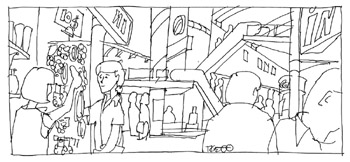The Most Important Person Is Ann
|
|
Most mobile phones have a memory for storing names and phone numbers. The phonebook application can be easily accessed with a single key press. The phonebook itself consists of up to 200 or 300 names in alphabetical order. Finding a desired name in the phonebook will-as in the menu-mean approximately 12 key presses to reach a listing and to make a call. If a person's name happens to be in the beginning of the alphabetical order, for example, 'Ann Adams,' it can be reached very quickly. On the other hand, poor Margaret Mayer is much more difficult to reach.
Most certainly, for any mobile phone user, not all names in the phone book are equal. If we ask randomly selected persons in the street what the most important aspects of their lives are, they typically include other people in the top three answers. In addition to good health and happiness, they will say 'my wife,' 'my boyfriend,' 'my family,' or 'good friends.' Although they always refer to one person or a very small group of people that matter most, the mobile phonebook always facilitates communication with names high up in the alphabetical order.[*]
This simple observation that the significance order of contacts is not the same as the alphabetical order of the phonebook-or any other rigid mechanical way of arranging contacts-is a start in recognizing that the mobile phones are not merely technical objects storing a fixed number of entries. They have the potentional to be representations of the most valuable things in the user's life: relationships with other people. Mobile phones could be designed in such a way that they would support creating, enjoying, and maintaining these relationships. The phone could provide features that help the user stay in contact with loved ones all the time. It could transmit information about the caller's current usage context to others. Users could know what their friends are doing, where they are, who they are with, and how they feel.

[*]J. Nielsen, Usability Engineering. San Diego: Academic Press, 1993.
|
|
EAN: 2147483647
Pages: 142